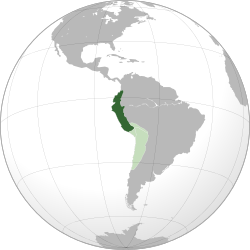Chinchay Suyu
Appearance
This article needs additional citations for verification. (June 2009) |
| Chinchay Suyu | |||||||
|---|---|---|---|---|---|---|---|
Suyu of Inca Empire | |||||||
| 1438–1529 | |||||||
 Chinchaysuyu within the Inca Empire | |||||||
| Historical era | Pre-Columbian Peru | ||||||
• Established | 1438 | ||||||
| 1529 | |||||||
| 1533 | |||||||
| Subdivisions | |||||||
| • Type | Wamani | ||||||
| |||||||
Chinchay Suyu or Chinchasuyu (
The name is due to the
Ica Region. Chinchay in Quechua stands for the tigrillo,[4] animal present, although not physically, in some cultures of this region due to the Amazonian influence during the Early Horizon and Early Intermediate, such as the Chavín culture or the commercial exchange between the Huarpa -civilization located in modern-day Ayacucho that had trading routes to the Amazonas- and Nazca
cultures.
Before the
Cuzco for burial beside the mummified bodies of his royal ancestors. The Inca Emperor Huascar
who was the eldest son of Huayna Capac, ruled the rest of the Inca Empire from Cuzco, and was displeased that Atahualpa was crown King in Quito. Spanish chroniclers refer to Atahualpa's Kingdom as the Kingdom of Quito. The Inca Huascar was not able to do anything since the best soldiers in the Inca Empire swore allegiance to Atahualpa.
After 4 or 5 years of peace, the nobles as well as the mother of the Inca Huascar, Rava Ocllo. encouraged him to reconquer the Kingdom of Atahualpa which spanned most of the Chinchasuyu. Huascar sent an ultimatum to Atahualpa asking for submission, Atahualpa refused, and a young General Atoc was sent to invade and reconquer the Kingdom of Quito from Atahualpa.

Wamani

Each suyu was divided into wamani, or provinces. Chinchaysuyu included the wamani of:
- Atavillo of Atawillu, in the modern province of Canta.
- Ayavaca or Ayawax’a
- Cajamarca or Q’asamarka
- Cajatamboor Q’asatampu
- Calva or Kalua
- Casma
- Wankatribe
- Chancay
- Chao or Suo
- Chicama
- Chicla or Chillqa
- Chimbote or Sancta
- Chimu, also called Moche.
- Chincha
- Chinchayqucha, also called in sources by the name of Junín.
- Conchuco
- Huacrachuco
- Huamachuco
- Huamali
- Huambo or Wampu
- Huancabambaor Wañkapampa
- Huancavilca or Wankawillka
- Huánuco
- Huarco, also called Runawana and Cañete
- Huarmey
- Huaura, also called Huacho or Supe
- Huaylaor Waylla
- Lambayeque, whose people spoke Mochica.
- Lima or Rimaq, a large province of perhaps 150,000 inhabitants.
- Lurin, home of the Oracle at Pachacamac.
- Mala
- Moyobamba or Moyopampa
- Nepeña or Wampachu
- Ocro, including both the Ocro and Lampa tribes.
- Olmos or Olmo
- Pacasmayo
- Parmunca
- Pinco, in Ancash Department
- Pisco
- Piura
- Shawsha[5] or Jauja
- Tarmaor Tarama
- Tumbes or Tumpis
- Virúor Wanapu, likely the origin of the word Perú.
- Yauyo, including the Laraotribe.
See also
- Organization of the Inca Empire
- Antisuyu
- Kuntisuyu
- Qullasuyu
- Chincha Kingdom
References
- ^ D’Altroy, Terence N. (2005). The Incas. Blackwell Publishing: Malden, p. 86-87
- ^ D’Altroy, Terence N. (2005). The Incas. Blackwell Publishing: Malden, p. 42-43, 86-89
- ^ Steward, Julian H. & Faron, Louis, C. (1959). Native Peoples of South America. McGraw-Hill: New York, p. 185-192
- ^ Definition recovered from https://aulex.org/qu-es/?busca=chinchay
- ISBN 9780292791909.
